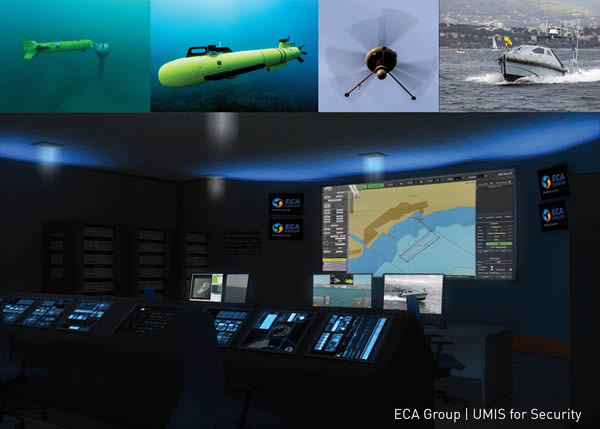WSi News2017-11-21 09:56:14
ECA Group presents its robotic solution for coastal security
A fleet of robots, controlled by one single software programme, monitoring our coastlines and protecting our ports...With this new coastal and port security solution presented by ECA Group, the future starts today.
The security of borders and sensitive sites is an ongoing concern and will be the focal point at the MILIPOL trade show taking place from 21 to 24 November 2017.
Dangers coming from the sea are particularly difficult to prevent before they reach the coastline. The reasons included existing surveillance systems are inadequate, insufficient resource capacity and the difficulty of anticipating these types of events.
Commercial ports are among the most vulnerable sites and their protection is defined by the ISPS code, an international standard that came into force about ten years ago, all the more justified as terrorism has become a global threat.
Without the help of new technologies, the coastal and port protection is a challenging mission. Nowadays, radars and multifunctional cameras ensure permanent monitoring. However, the current system has its limits as it uses fixed sensors installed at strategic points on the monitored sites. The fixed sensors can be blocked by precipitous terrains and their functioning can be disturbed by bad weather. This considerably restricts the viewing range. These constraints can have important consequences in critical situations and as coastal protection starts at sea, anticipation is crucial.
Dedicated to the security of coastal and port infrastructures, the solution UMIS for Security that ECA Group is about to commercialise promises a significant change.
To improve the performance of current devices, ECA Group, specialised in robotics for hostile environments, provides a simple and efficient solution dedicated to coastal and port security which deploys different types of developed robots.
“In order to lift the limitations linked to the fixed sensors, ECA Group has designed solutions that make the sensors mobile. These solutions provide more precise and performant information with a wider viewing range. They enable to better detect dangers and to generate alerts well in advance so that action can be taken at sea and infrastructures can be protected. ”, explains Vincent Clavier, in charge of Homeland Security activity within ECA Group.
ECA Group’s idea is both simple and extremely sophisticated and even futuristic as it is a fleet of different robots that is going to wear the sensors. The entire fleet can be regrouped, managed and coordinated with one single command post equipped with the new software suite UMIS for Security.
"The real novelty of this software suite is its ability to integrate seamlessly into existing systems, its primary purpose being the supplementing of the already installed devices. The added value is its ability to supervise the fleet of sensors, to process and communicate information and as well to manage, operate and coordinate the robots’ tasks. UMIS for Security provides access to a global and interactive situation interface, with the option to define surveillance zones for example, generate alerts, transmit commands and react before the danger reaches the zone requiring protection, and all of this without putting humans at risk. “.
In a nutshell, a global and complete solution providing better detection of threats and therefore improvement port security while maintaining a rapid and responsive capacity to intervene over an extended period.
ECA Group proposes three types of robots that can wear the mobile sensors. The main device is USV INSPECTOR MK2, an unmanned boat functioning by remote control or navigating in autonomous mode (the operator pre-programmes the itinerary), specifically configured for port security and amazingly efficient in the fight against terrorism, malicious or activism acts.
"INSPECTOR MK2 patrols and controls sensitive areas equipped with a multi camera set-up, radars and effectors or other payloads to keep out intruders. The scope of surveillance and global detection is substantially increased in a sustainable manner while avoiding unnecessary or dangerous call-outs by response teams.”, clarifies Vincent Clavier.
When necessary, INSPECTOR MK2 can escort suspicious boats to the entrance of the port to collect as much information as possible and generate a warning provoking a response. In the most critical situations, for example is a weapon has been detected on board, USV of the ECA Group can also step in to keep out the intruder and avoid the worst. This naval surface drone can be equipped with radars, visual or thermal cameras and transmit images in real time or other detailed information such as heat sources, biochemical or radiological components.
High impact deterrents can be deployed as well: water cannons, visual or acoustic projectors and even lethal means.
“The robots are going to try and defeat the threat. However, their purpose is to assist humans not to replace them as critical situations should not be dehumanized.”, says Vincent Clavier.
This equipment can be supplemented with a second type of ECA Group underwater robots; They can be autonomous (AUVs) such as the A9-E or remotely operated (ROV) like the SEASCAN. These devices inspect the seabed along the coastline to verify whether the seabed has been modified (check on dumping but also mines or improvised explosives).
The third family of robots is made of aerial drone UAV IT180. They carry out speedy reconnaissance flights and surveillance or inspection flights (chemical sensors, magnetometers, etc.) These IT180 mini drones are known to be very stable, robust and resistant in very bad weather conditions. They can be fitted with various payloads and take pictures with high resolution cameras, etc.
These different robots are complementary and work together in order to provide the operator with a complete status report. The operator can work safely from his “control tower” and act at a distance.
UMIS for Security is also available with a mobile command station. The system is installed in an equipped truck that can be deployed occasionally for specific call-outs, for example the securing of an area where a large event or gathering will take place.
